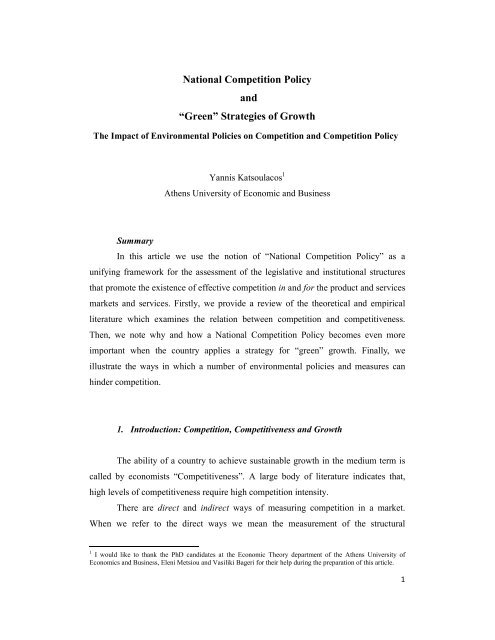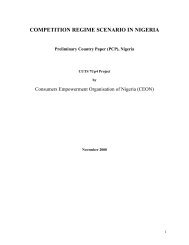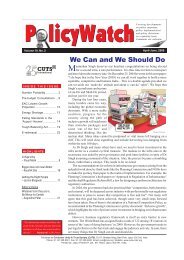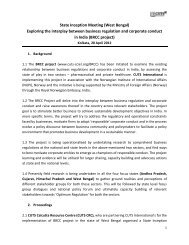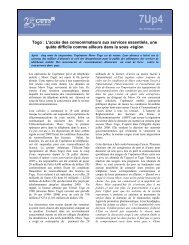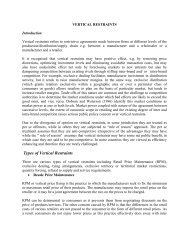National Competition Policy and âGreenâ Strategies of ... - cuts ccier
National Competition Policy and âGreenâ Strategies of ... - cuts ccier
National Competition Policy and âGreenâ Strategies of ... - cuts ccier
Create successful ePaper yourself
Turn your PDF publications into a flip-book with our unique Google optimized e-Paper software.
<strong>National</strong> <strong>Competition</strong> <strong>Policy</strong><br />
<strong>and</strong><br />
“Green” <strong>Strategies</strong> <strong>of</strong> Growth<br />
The Impact <strong>of</strong> Environmental Policies on <strong>Competition</strong> <strong>and</strong> <strong>Competition</strong> <strong>Policy</strong><br />
Yannis Katsoulacos 1<br />
Athens University <strong>of</strong> Economic <strong>and</strong> Business<br />
Summary<br />
In this article we use the notion <strong>of</strong> “<strong>National</strong> <strong>Competition</strong> <strong>Policy</strong>” as a<br />
unifying framework for the assessment <strong>of</strong> the legislative <strong>and</strong> institutional structures<br />
that promote the existence <strong>of</strong> effective competition in <strong>and</strong> for the product <strong>and</strong> services<br />
markets <strong>and</strong> services. Firstly, we provide a review <strong>of</strong> the theoretical <strong>and</strong> empirical<br />
literature which examines the relation between competition <strong>and</strong> competitiveness.<br />
Then, we note why <strong>and</strong> how a <strong>National</strong> <strong>Competition</strong> <strong>Policy</strong> becomes even more<br />
important when the country applies a strategy for “green” growth. Finally, we<br />
illustrate the ways in which a number <strong>of</strong> environmental policies <strong>and</strong> measures can<br />
hinder competition.<br />
1. Introduction: <strong>Competition</strong>, Competitiveness <strong>and</strong> Growth<br />
The ability <strong>of</strong> a country to achieve sustainable growth in the medium term is<br />
called by economists “Competitiveness”. A large body <strong>of</strong> literature indicates that,<br />
high levels <strong>of</strong> competitiveness require high competition intensity.<br />
There are direct <strong>and</strong> indirect ways <strong>of</strong> measuring competition in a market.<br />
When we refer to the direct ways we mean the measurement <strong>of</strong> the structural<br />
1 I would like to thank the PhD c<strong>and</strong>idates at the Economic Theory department <strong>of</strong> the Athens University <strong>of</strong><br />
Economics <strong>and</strong> Business, Eleni Metsiou <strong>and</strong> Vasiliki Bageri for their help during the preparation <strong>of</strong> this article.<br />
1
characteristics <strong>and</strong> the performance indices <strong>of</strong> the market, such as the degree <strong>of</strong><br />
concentration <strong>and</strong> firm’s pr<strong>of</strong>itability. On the other h<strong>and</strong>, the indirect ways, have to do<br />
with the effect <strong>of</strong> the various policies <strong>and</strong> regulations on competition.<br />
At the same time, the positive effects generated by competition can be direct,<br />
such as price reduction <strong>and</strong> quality improvement <strong>and</strong> indirect, through the increase in<br />
firms’ innovativeness. This means that competition is necessary for low prices <strong>and</strong><br />
high quality <strong>of</strong> products <strong>and</strong> services but also very significant for high productivity<br />
<strong>and</strong> for high <strong>and</strong> sustainable growth rates.<br />
The effects <strong>of</strong> competition on growth, market liberalization <strong>and</strong> innovativeness<br />
have been examined in many theoretical <strong>and</strong> empirical studies. For example, Nickell 2<br />
(1996), Nickell et. al. 3 (1997), Blanchflower <strong>and</strong> Machin 4 , (1996), Bloom <strong>and</strong> Van<br />
Reenen 5 (2007) proved that competition improves the productivity <strong>of</strong> firms.<br />
<strong>Competition</strong> also implies easy entry <strong>and</strong> exit from markets. Many studies confirm the<br />
positive impact on the level <strong>and</strong> growth rate <strong>of</strong> productivity, at the level <strong>of</strong> sector <strong>and</strong><br />
country, <strong>of</strong> the liberalization <strong>of</strong> trade <strong>and</strong> <strong>of</strong> markets. Such studies are: VanWijnbergen<br />
<strong>and</strong> Venables 6 (1993), Baily <strong>and</strong> Gerbach 7 (1995) <strong>and</strong> Nickell (1996), while an OECD<br />
study, with evidence from 6 countries concludes that 10-40% <strong>of</strong> the rate <strong>of</strong> growth <strong>of</strong><br />
productivity is due to “firm turnover”. Finally, competition generally improves<br />
innovativeness. A relevant paper is that from Blundell et.al. 8 , (1999). The main<br />
reason is that in markets with high competition intensity this drives firms to<br />
innovation in order to “escape” the effect <strong>of</strong> competition on their pr<strong>of</strong>it (escape<br />
competition effect). Perhaps this is the most significant factor in the effect <strong>of</strong><br />
2 Nickell, S., 1996. <strong>Competition</strong> <strong>and</strong> corporate performance. Journal <strong>of</strong> Political Economy 104, pages<br />
724–746.<br />
3 Nickell, S., Nicolitsas, D. <strong>and</strong> Dryden N., 1997, What makes firms perform well?, European Economic<br />
Review, Vol. 41, Issues 3-5, pages 783-796.<br />
4 Blanchflower, D. <strong>and</strong> Machin, S., 1996, Product Market <strong>Competition</strong> Wages <strong>and</strong> Productivity:<br />
International Evidence from Establishment-Level Data, Annales d’Économie et de Statistique, pages<br />
219-253.<br />
5 Bloom, N. <strong>and</strong> Van Reenen, J., 2007, Measuring <strong>and</strong> Explaining Management Practices Across Firms<br />
<strong>and</strong> Countries, Quarterly Journal <strong>of</strong> Economics, Vol. 122, No. 4, pages 1351-1408.<br />
6 Venables, A.J., Van Wijnbergen, S., 1993, Trade liberalization, productivity, <strong>and</strong> competition: the<br />
Mexican experience, mimeo, Centre for Economic Performance, London School <strong>of</strong> Economics.<br />
7 Baily, M.N. <strong>and</strong> Gersbach, H., 1995, Efficiency in manufacturing <strong>and</strong> the need for global competition.<br />
Brookings Papers on Economic Activity (Microeconomics), pages 307–347.<br />
8 Blundell, R., Griffiths, R., Van reenen, J., 1999, Market Share, Market Value <strong>and</strong> Innovation in a Panel<br />
<strong>of</strong> British Manufacturing Firms, Review <strong>of</strong> Economic Studies, Vol. 66, issue 3, pages 529-554.<br />
2
competition on growth. It is worth stressing that innovativeness allows firms to<br />
increase their pr<strong>of</strong>it <strong>and</strong> to grow in an environment <strong>of</strong> low inflation.<br />
Recent empirical studies have, also, examined the impact <strong>of</strong> indirect measures<br />
<strong>of</strong> competition intensity, particularly the impact <strong>of</strong> various state policies/regulations<br />
that reduce the intensity <strong>of</strong> competition, making use <strong>of</strong> a number <strong>of</strong> indices like<br />
indices <strong>of</strong> the «intensity <strong>of</strong> regulatory intervention» in product markets (see<br />
Nicoletti et al. 9 (1999)). These studies confirm the positive impact <strong>of</strong> competition on<br />
innovativeness <strong>and</strong> show that a high intensity <strong>of</strong> regulatory intervention in product<br />
markets has especially negative impact on the rate <strong>of</strong> productivity growth when a<br />
country is not near the «technological frontier», because this impedes the adoption <strong>of</strong><br />
new technologies.<br />
Finally, more recent studies have examined the impact <strong>of</strong> environmental<br />
policies, associated with green (low-carbon) growth strategies, on competition <strong>and</strong> the<br />
implications for competition policy - for example the “<strong>Competition</strong> <strong>Policy</strong> <strong>and</strong> Green<br />
Growth, 2010” report by Nordic <strong>Competition</strong> Authorities, on which the second part <strong>of</strong><br />
this presentation is based.<br />
These studies are motivated by the strong <strong>and</strong> growing policy emphasis on the<br />
development <strong>of</strong> green growth strategies, which is reflected on the fact that ministers<br />
<strong>of</strong> 34 countries at the OECD Ministerial Council meeting <strong>of</strong> June 2009 endorsed a<br />
m<strong>and</strong>ate for the OECD to develop a Green Growth Strategy. In turn, the above report<br />
examines the challenges that <strong>Competition</strong> Authorities face in respect <strong>of</strong> the shift<br />
towards green growth.<br />
The results from this analysis clearly show that <strong>National</strong> <strong>Competition</strong><br />
Policies need to take into account this shift towards green growth.<br />
9 Nicoletti, G., Scarpetta, S. <strong>and</strong> Boylaud, O., 1999, Summary indicators <strong>of</strong> product market regulation<br />
with an extension to employment protection legislation, OECD Economics Department Working<br />
Papers, No.226.<br />
3
2. The meaning <strong>of</strong> <strong>National</strong> <strong>Competition</strong> <strong>Policy</strong><br />
The <strong>National</strong> <strong>Competition</strong> <strong>Policy</strong> (NCP) includes <strong>Competition</strong> <strong>Policy</strong> in the<br />
narrow sense – that is, the <strong>Competition</strong> Law, which prohibits <strong>and</strong> deters firm<br />
behavior/practices that distort <strong>and</strong> lessen existing <strong>and</strong> / or potential competition<br />
(various dominant firm practices, cartels <strong>and</strong> some horizontal <strong>and</strong> vertical mergers).<br />
However, this is certainly NOT enough for creating conditions <strong>of</strong> effective<br />
competition in markets. In order to create such conditions a modern legal <strong>and</strong><br />
institutional framework is required with particular emphasis on the independence <strong>of</strong><br />
the <strong>Competition</strong> Authority, on the principle <strong>of</strong> competitive neutrality <strong>and</strong> on<br />
effective enforcement procedures.<br />
In addition, it is necessary to have measures, policies <strong>and</strong> institutions for the<br />
creation <strong>of</strong> free entry <strong>and</strong> exit conditions in markets, through the abolishment <strong>of</strong> laws<br />
<strong>and</strong> regulations that distort <strong>and</strong> hinder competition <strong>and</strong> create regulatory burden <strong>and</strong><br />
through the reduction <strong>of</strong> corruption.<br />
Finally, one more characteristic that NCP should include for the preservation<br />
<strong>and</strong> promotion <strong>of</strong> efficient competition are measures for the development <strong>and</strong><br />
proliferation <strong>of</strong> a culture <strong>of</strong> competition – so that the competitive spirit imbues the<br />
whole economy.<br />
The importance <strong>of</strong> NCP lies in the benefits that <strong>Competition</strong> <strong>Policy</strong> generates.<br />
For example, as Ph. Lowe, the Director-General <strong>of</strong> DG COMP stated in 2007:<br />
«…<strong>Competition</strong> <strong>Policy</strong> plays a very significant role in the strategy for Growth <strong>and</strong><br />
Employment adopted from 25 EU countries, in the frame <strong>of</strong> the review <strong>of</strong> the 2005<br />
Lisbon strategy». Furthermore, as the (former) EU <strong>Competition</strong> Commissioner Kroes<br />
(2008) has noted, between 2004-8, the decisions <strong>of</strong> DG COMP <strong>of</strong> the EC on Cartels<br />
led to direct <strong>and</strong> indirect benefits to consumers <strong>of</strong> over 24 billion euro. Equally<br />
important were the benefits from the decisions related to the abuse <strong>of</strong> dominance <strong>and</strong><br />
anti-competitive mergers. A typical example <strong>of</strong> the effect <strong>of</strong> market liberalization <strong>and</strong><br />
deregulation can be seen in European air transport, between 1992 – 2002, where there<br />
was an increase in travel frequency <strong>of</strong> 78% while prices fell by 66%!<br />
4
In a recent article, that also contains a good review <strong>of</strong> the empirical studies<br />
related to the impact <strong>of</strong> CP on growth, Buccirossi et.al. 10 (CEPR, 2010) examine<br />
extensively the impact <strong>of</strong> an index <strong>of</strong> the quality <strong>of</strong> <strong>Competition</strong> <strong>Policy</strong> (the<br />
<strong>Competition</strong> <strong>Policy</strong> Index, CPI) on Total Factor Productivity growth for 22 sectors in<br />
12 countries <strong>of</strong> OECD in the period 1995 – 2005. They find a significant positive<br />
impact <strong>of</strong> CPI <strong>and</strong> show that the relation can be interpreted as a causal one. As they<br />
note concluding: “Our results provide support for the argument that investing<br />
resources in competition policy is beneficial to the long-term performance <strong>of</strong> a<br />
country’s economy”. Other studies such as Krakowski M. 11 (2005), Dutz M & A.<br />
Hayri 12 (1999), Mateus A. 13 (2010), Jenny F. 14 (2008), confirm this result.<br />
Although effective <strong>Competition</strong> Law enforcement is important, the other<br />
aspects <strong>of</strong> a NCP are equally or even more important. Such aspects are the<br />
abolishment <strong>of</strong> the government regulations that hinder competition <strong>and</strong> the reduction<br />
<strong>of</strong> corruption. Absent these, competition COULD NOT function satisfactorily.<br />
In relation to this, it is known that governments intervene in markets not only<br />
in cases where significant market failures occur but in a lot <strong>of</strong> other cases as well. For<br />
example, markets with sufficient competition intensity have frequently undergone<br />
excessive regulation. These regulations usually take the form <strong>of</strong> entry restrictions <strong>and</strong><br />
price controls. The social cost from these regulations (Regulatory Burden) can be<br />
very important.<br />
There are various examples <strong>of</strong> results from empirical studies:<br />
-About 20% <strong>of</strong> the reduction in the increase <strong>of</strong> the rate <strong>of</strong> growth <strong>of</strong> labor<br />
productivity in the USA in 1970’s compared to that in the period 1958-1965 was due<br />
to the increase <strong>of</strong> regulations in the mid 1960’s.<br />
-According to the OECD report (2000), deregulation <strong>of</strong> markets would lead to<br />
an increase in GDP <strong>of</strong> about 5% to 6% in France <strong>and</strong> Germany <strong>and</strong> 10% in Greece.<br />
Another basic component <strong>of</strong> NCP should be the confrontation <strong>of</strong> Corruption.<br />
10 Buccirossi, P., L. Ciari, T. Duso, G. Spagnolo <strong>and</strong> Cr. Vitale, 2009, <strong>Competition</strong> <strong>Policy</strong> <strong>and</strong> Productivity<br />
Growth: An Empirical Assessment, Centre for Economic <strong>Policy</strong> Research, Discussion Paper No. 7470.<br />
11 Krakowski M., 1995, <strong>Competition</strong> <strong>Policy</strong> Works: The Effect <strong>of</strong> <strong>Competition</strong> <strong>Policy</strong> on the Intensity <strong>of</strong><br />
<strong>Competition</strong> – An International Cross – Country Comparison, HWWA, Discussion Paper 332.<br />
12 Dutz, M.A., Hayri, A., 1999, Does more intense competition lead to higher growth?, CEPR, Discussion Paper<br />
No. 2249.<br />
13 Mateus A., 2010, <strong>Competition</strong> <strong>and</strong> Development: What <strong>Competition</strong> Law Regime?, available at SSRN.<br />
14 Jenny F., 2008, The CFI Decision in Micros<strong>of</strong>t: Why the European Commission’s guidelines on abuse <strong>of</strong><br />
dominance are necessary <strong>and</strong> possible, <strong>Competition</strong> <strong>Policy</strong>, Vol.-, issue 2, p.1-10.<br />
5
As is shown in recent studies, corruption generates social costs MAINLY due to the<br />
fact that it acts as a very high entry barrier (bureaucrats choose the height <strong>of</strong> entry<br />
barriers in order to maximize their income from bribery). Recent empirical research<br />
has shown that corruption is the most important entry barrier for new firms – even<br />
more important than financial factors, taxation <strong>and</strong> government regulations (see, for<br />
example, Campos, Estrin <strong>and</strong> Proto 15 (2010)).<br />
We can now turn more specifically to the implications <strong>of</strong> green growth<br />
strategies for NCP.<br />
3. <strong>Competition</strong> <strong>Policy</strong> <strong>and</strong> Environmental <strong>Policy</strong> (EP) 16<br />
Below we suggest that formulating <strong>and</strong> enforcing a NCP is even more<br />
important when the country applies an Environmental <strong>Policy</strong> which aims at<br />
“green” growth. There are significant relations between <strong>Competition</strong> <strong>Policy</strong> <strong>and</strong><br />
Environmental <strong>Policy</strong> – especially between <strong>Competition</strong> <strong>Policy</strong> <strong>and</strong> the “Green<br />
Growth” strategies which have been advocated by many countries in recent years.<br />
But, while competition policy may be regarded as highly supportive <strong>of</strong><br />
environmental policy the reverse is not true.<br />
As already mentioned, <strong>Competition</strong> <strong>Policy</strong> has a very important role to play in<br />
the context <strong>of</strong> the shift towards green growth strategies.<br />
To begin with, conditions <strong>of</strong> effective competition can support substantially the<br />
achievement <strong>of</strong> environmental targets in the framework <strong>of</strong> a well-designed<br />
environmental strategy for “Green Growth”. This is so given that under conditions <strong>of</strong><br />
effective competition prices reflect accurately the social marginal cost <strong>of</strong><br />
environmental externalities <strong>and</strong> provide the right incentives for the reduction <strong>of</strong><br />
environmental pollution <strong>and</strong> for investments on “green technologies”. Moreover,<br />
effective competition, with low entry barriers, also ensures that there are incentives<br />
for innovation <strong>and</strong> that environmental targets are achieved with the most cost<br />
effective way.<br />
15 Campos N., S. Estrin <strong>and</strong> E. Proto, 2010, Corruption as a Barrier to Entry: Theory <strong>and</strong> Evidence, CEPR,<br />
Discussion Paper No. DP8061.<br />
16 As mentioned above this section is based on the “<strong>Competition</strong> <strong>Policy</strong> <strong>and</strong> Green Growth, 2010”<br />
report by Nordic <strong>Competition</strong> Authorities<br />
6
However, there are many environmental policies <strong>and</strong> measures that can<br />
hinder competition <strong>and</strong> it is crucial that the NCP recognizes <strong>and</strong> takes into account<br />
these effects. The application <strong>of</strong> environmental policies can hinder competition in<br />
various ways. These can be broadly grouped into two categories: a) raising market<br />
concentration <strong>and</strong> entry barriers <strong>and</strong> b) through collusive practices. We consider each<br />
in turn:<br />
a) Raising market concentration <strong>and</strong> entry barriers<br />
1. Compliance to environmental regulations seems to favor larger firms as these<br />
firms face lower per unit costs <strong>of</strong> compliance (see for example,<br />
“Environmental Regulation <strong>and</strong> <strong>Competition</strong>”, OECD, 2006). This suggests<br />
that substantial fixed costs are associated with compliance. As a result<br />
environmental regulations increase the Minimum Efficient Scale <strong>of</strong> production<br />
<strong>and</strong>, thus, the degree <strong>of</strong> market concentration. This inevitably reduces<br />
competition.<br />
2. Incumbent firms with market power may support <strong>and</strong> lobby for stricter<br />
environmental st<strong>and</strong>ards than those necessary, in order to “raise the costs <strong>of</strong><br />
smaller existing rivals <strong>and</strong> <strong>of</strong> potential competitors” <strong>and</strong> thus enhance their<br />
market power – despite <strong>of</strong> the fact that, as a result, they themselves face higher<br />
production costs.<br />
3. Often, incumbent firms face less stringent environmental st<strong>and</strong>ards than firms<br />
that are starting production. An important reason for this is that it tends to be<br />
more difficult / expensive to improve the environmental characteristics <strong>of</strong><br />
production facilities afterwards than to build them up to the st<strong>and</strong>ard in the<br />
beginning.<br />
Recognizing this extra cost, regulators <strong>of</strong>ten use so-called “Gr<strong>and</strong>fathering”<br />
policies i.e. impose less stringent environmental st<strong>and</strong>ards on incumbent<br />
firms.<br />
These policies create barriers to entry to potential new entrants, thus reducing<br />
competition <strong>and</strong> raising the market power <strong>of</strong> incumbents.<br />
7
4. Another reason that entry barriers can be raised is that environmental<br />
regulations increase the sunk costs (e.g. all the time spent on procedural<br />
matters <strong>and</strong> red-type is sunk cost) <strong>of</strong> market entry as well as the exit costs –<br />
thus again reducing competition intensity.<br />
5. In the specific cases where direct emission taxes are imposed it is usual that<br />
they lead to an increase in market concentration <strong>and</strong> reduced competition, as<br />
in those cases larger firms find it more advantageous to invest in pollution<br />
reducing equipment <strong>and</strong> pay less tax than small firms do.<br />
b) Collusive practices<br />
We now turn to the second category, i.e. the ways environmental policy can<br />
hinder competition through collusive practices.<br />
Successful environmental policies improve, ceteris paribus, social welfare <strong>and</strong><br />
so can be used to defend horizontal agreements that would be otherwise deemed<br />
restrictive under competition law. However restrictive practices can lead to significant<br />
reductions in consumer welfare <strong>and</strong> certainly they cannot be defended merely by<br />
pointing to some unspecified <strong>and</strong> unquantified social good. To do so would render<br />
competition policy completely ineffective.<br />
Thus, if environmental policies create social gains these should be taken into<br />
account by <strong>Competition</strong> Authorities through the requirement <strong>of</strong> significant<br />
“efficiencies” as defined in competition law. Implicit here is a clear recommendation<br />
for policy makers on how to make competition <strong>and</strong> environmental policy compatible<br />
<strong>and</strong> increase overall economic efficiency.<br />
Bellow we present examples <strong>of</strong> horizontal agreement concerns:<br />
6. Concerning the implementation <strong>of</strong> Emission Trading Schemes – in EU this is<br />
regarded as one <strong>of</strong> the cornerstones <strong>of</strong> EU climate policy – it is <strong>of</strong>ten<br />
advocated that emission permits should be auctioned <strong>and</strong> that there should not<br />
be any preferential treatment.<br />
8
Here, auction design is very important for promoting efficient pricing <strong>and</strong><br />
avoiding collusion. Collusion would result in too low prices for the permits,<br />
leading to lower incentives for innovation in “clean technologies” <strong>and</strong> to lower<br />
government auction revenues than those that reflect the real economic value <strong>of</strong><br />
the emission permits.<br />
The <strong>Competition</strong> Authorities have an important task to detect <strong>and</strong> deter<br />
collusive practices before, during <strong>and</strong> after the auction process.<br />
7. Public Procurement is generally regarded as an important tool for securing<br />
growth <strong>and</strong> employment. An example <strong>and</strong> pro<strong>of</strong> <strong>of</strong> its importance is the fact<br />
that in Nordic countries public procurement accounts for 16% <strong>of</strong> GNP. Public<br />
procurement is now seen as a tool for public bodies to implement green policy.<br />
When public bodies introduce environmental criteria in public procurement it<br />
is called Green Public Procurement (GPP).<br />
Today, about 20 EU member states have adopted a <strong>National</strong> Action Plan for<br />
GPP to be used to promote markets for green goods.<br />
However it is important that GPP is used only for goods that have a substantial<br />
impact on the environment AND for which the external effects are not already<br />
internalized by other regulatory instruments, since:<br />
- GPP can have a negative impact on competition because it can lead to the<br />
participation <strong>and</strong> the submission <strong>of</strong> <strong>of</strong>fers <strong>of</strong> much fewer firms – those that<br />
satisfy the (new) environmental criteria – thus raising also the likelihood <strong>of</strong><br />
collusion in the bidding process.<br />
- Prices to the procuring entity will tend to rise as a result <strong>of</strong> the above reduction<br />
in competition <strong>and</strong>/or as a result <strong>of</strong> firms’ facing increased costs in order to<br />
satisfy the (new) environmental criteria.<br />
8. Environmental agreements between firms – e.g. expressed through joint<br />
commitments to contributing to the attainment <strong>of</strong> a sector-wide environmental<br />
target – may serve as a tool to engage in a disguised cartel (<strong>and</strong> they can be in<br />
breach <strong>of</strong> <strong>Competition</strong> Law, as, for example, <strong>of</strong> article 101 TFEU <strong>of</strong> the EU).<br />
9
9. In the very important sectors <strong>of</strong> recycling <strong>and</strong> waste management<br />
environmental authorities <strong>of</strong>ten support sector-based agreements (green<br />
schemes) among the firms which may cause substantial problems to<br />
competition.<br />
A typical green scheme would be a horizontal agreement set up to comply<br />
with environmental obligations related to recycling or returnable products.<br />
Such schemes can extend to entire industries <strong>and</strong> usually comprise a complex<br />
set <strong>of</strong> arrangements which may be either horizontal or vertical or both.<br />
As noted in the Nordic CAs report (2010) [Section 5.2], green schemes could<br />
raise competition concerns related to (a) sensitive information exchange <strong>and</strong><br />
commonality <strong>of</strong> costs that would facilitate collusion in product markets (b)<br />
bundling <strong>of</strong> dem<strong>and</strong> for collection <strong>and</strong> sorting services <strong>and</strong> (c) the pricing <strong>and</strong><br />
fee structure.<br />
In the light <strong>of</strong> all the above, <strong>Competition</strong> Authorities have a very important<br />
role to play in the application <strong>of</strong> green growth strategies. They should be able to<br />
identify <strong>and</strong> to analyze environmental regulations which may negatively affect<br />
competition. Moreover, in collaboration with the environmental authorities, they<br />
should assess the effects on competition <strong>of</strong> the environmental policies <strong>and</strong> regulations<br />
<strong>and</strong> they should compare the environmental benefits with the social cost that may<br />
arise from the hindering <strong>of</strong> competition.<br />
The OECD <strong>Competition</strong> Assessment Toolkit (2006) <strong>of</strong>fers very useful<br />
instructions for <strong>Competition</strong> Authorities <strong>and</strong> other (sector-based regulatory)<br />
Authorities concerning the revision <strong>of</strong> environmental regulations in order to minimize<br />
the risk <strong>of</strong> negative effects on competition.<br />
4. Conclusions<br />
Environmental policies can have a significant impact on competition <strong>and</strong><br />
therefore they have very important implications for the formulation <strong>of</strong> <strong>National</strong><br />
<strong>Competition</strong> <strong>Policy</strong> <strong>and</strong> the enforcement <strong>of</strong> competition law.<br />
10
For the moment these significant impacts <strong>of</strong> green growth strategies do not<br />
seem to be carefully identified <strong>and</strong> assessed by <strong>Competition</strong> Authorities in most<br />
countries.<br />
11


